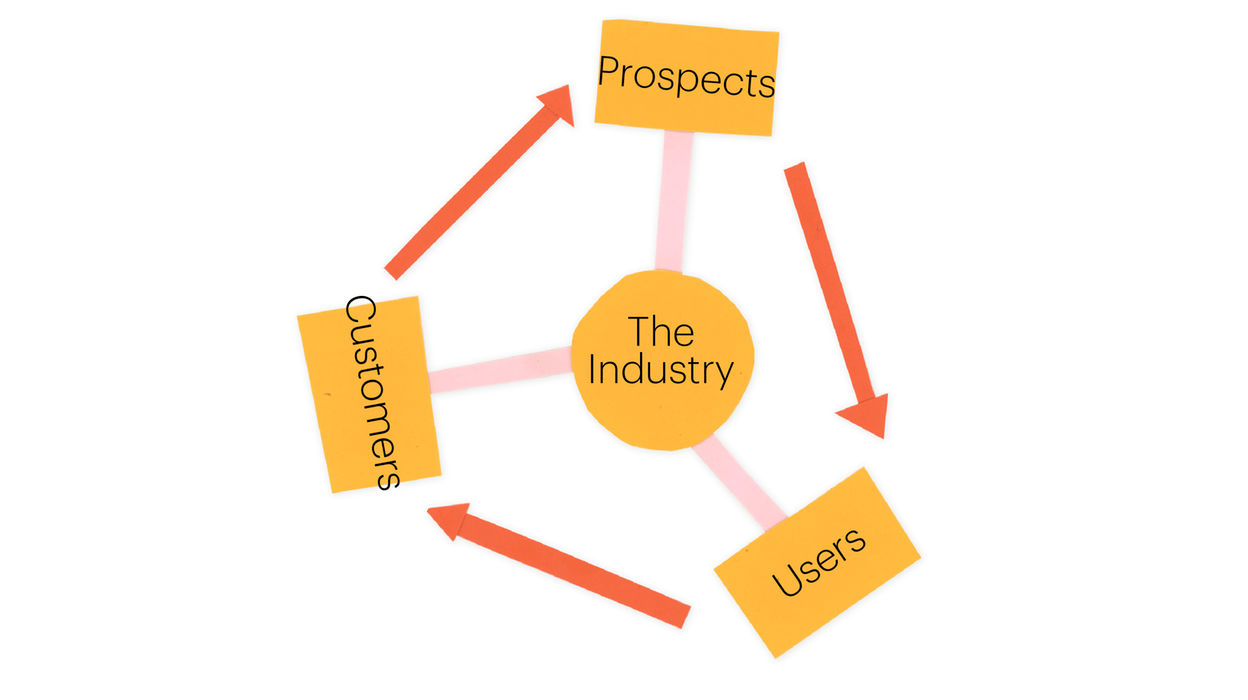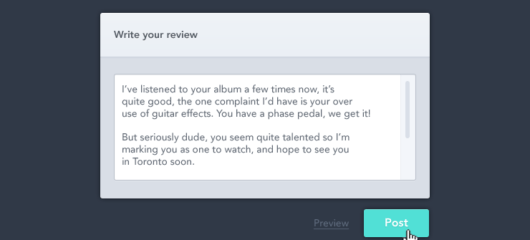
Connect and conquer – build your brand by staging events
Main illustration: Luke Waller
Of all the ways to get your message into the world, staging events might not seem like the most efficient or scalable. But that misses a few important qualities that only live events can offer.
In our industry there are dozens, if not hundreds of ways you can get in front of your customers or people you’d like to be your customers. When resources are low, impact is key. And where opportunities lie, choices have to be made. To do that, it’s not enough to replicate textbook marketing strategies. It’s important to ask yourself: “What’s different?” or “What could be different?”
Events rely on difference. They get someone’s attention for a long period of time, in a space that you design and create yourself, for the people that you want to meet, that day. During that time, you get to have your own voice and their consideration. This isn’t something you get with a landing page or a billboard. It’s something you definitely don’t get with paid advertising either.
Is it as measurable? Not always. Is it easy? Definitely not. But when you’re just starting up, bar knocking on someone’s front door, this is the most targeted, proactive, personal way you can meet the people you need to meet and build lasting relationships.
Staging events to remember
Businesses have been giving prospects and customers “an experience to remember” for hundreds of years. Big meals, golf trips, suited drivers, nice cars, champagne – the works. Those investments have felt good for those in it for the ride, have raised an eyebrow for those on the sidelines, hitting budgets hard and somewhere along the line, have made business sense.
Well-executed events can attract, convert, educate, nurture or delight your audience
The truth is that nothing has truly changed. Companies still do that. They’re now just called “events.” Well-executed events can attract, convert, educate, nurture or delight your audience, depending on how strategic and thorough you’re willing to get.
Product positioning, knowledge and brand awareness are your first ports of call in the early days. Unlike other functions that you have (or will have) in your company, staging events can directly connect you to four audiences at once: your customers (the people who pay you), your users (the people who use your product), your prospects (people you want to become customers) and the rest of the industry. That’s a big opportunity waiting for your attention, so why doesn’t everyone just jump off of the ledge?

During the first few years of building your business events are hard to justify. They cost a lot when money is tight and they’re difficult to measure. While it’s easy to be suspicious of business activities that don’t translate well on a spreadsheet, it doesn’t mean they’re not worth doing. Your business relies on having customers that are going to last, so relationships matter.
Of course, talking to people and building relationships is harder than sitting at your desk. You can’t just lock yourself in a room or outsource it to some agency. Staging events might be a lot harder than some other tactics, but nobody said marketing was easy.
It’s never too early to build events and it’s never too early to meet and conquer.
Meet your audience where they already are
Once you start building your product, there’s a whole audience out there waiting to hear about you and your product. That means from day one, your strategy to meet and spend time with your audience is about dividing and conquering.
Get comfortable traveling to your audience rather than expecting them to come to you
To do this, you should dial-in your company’s philosophy (who you are and what you care about), your product philosophy (why your product exists and where it is going) and make your first set of goals about how you’d like to meet and best spend time with your audience.
An essential part of starting out is creating a moving target for your company. Get comfortable traveling to your audience rather than expecting them to come to you, whether that’s conferences related to your product or meetups organised by like-minded people. That’s likely going to be your most significant resource and finance drain at the start of building your events strategy. Invest enough time in staging events and eventually they’ll be willing to fly to you, but not on day one.

Use existing channels to your advantage
Finance can feel like a blocker to getting started but lack of funding is a forcing function to putting thought-first. If your budget is low — it should be for events in the early stages — use channels that others have created before you and paths that have already been cleared.
The most obvious carrot in many cases is a tech conference that fits your target customer audience. While most events are about mutual buy-in between you and attendees, know that conferences are not. They’re an indirect partnership where the cards are heavily stacked in the conference’s favour.
You can gain a lot for free, and you can give a lot for free
With the wrong mindset or context, a conference will take your money and leave you hungry. It’s not a conference’s job to do a good job for you. It’s your job to buy their audience and do something with it. Don’t spend your precious early dollars on them and don’t spend your last — you won’t get them back. Start spending big money on conferences only when they allow you to be specific, aggressive or competitive. That’s impossible when you’re small.
Until then, host spin-off events during the conferences that may be in your town, or those you’re speaking at, pitching at or attending already. At least 50% of most tech conference tickets are given away for free to attract a large crowd — make a plea, trade or friend, there are ways to save here, so find one. When you’re there, tap into the conference’s press attendance and pitch them a story ahead of time or ask them to meet you. You can gain a lot for free, and you can give a lot for free. That’s what conferences are about.
A bad version of this opportunity is spending half of your annual marketing budget on sponsoring a conference closing party. Sure, your logo will be on a balloon or napkin, but no one will care. People at this stage are tired, thirsty and up for one last dance — they’ve had a long week. They won’t care because they’re not attending the event on account of your product, to meet you or to gain something from your company.
If your audience doesn’t share your goals from the first moment of your event you’re wasting your time and money. You can’t expect to host a regional drink up and collect 1,000 leads. If you’re ever in doubt here’s a sanity check. If a conference isn’t willing to pay for it themselves it’s not valuable to them, or a milestone deal breaker for them or their audience either. Don’t be that person that gives them the extra thing that doesn’t add value.
And then build your own
When you’re using paths others have laid down before you, it’s best to do something that you can control e.g. host office hours with customers you’ve never met, that could be using your product in a better way.
These moments define how people think of you and your company
Meet them in a quality coffee or tea shop near the conference that’s on-brand for your company, has a generous amount of space and has good Wi-Fi. Be sure to let the store know that you’re showing up ahead of time and will be spending time there. You’d be surprised by the kind of setup they’d be happy to organize for you.
You could also host an invite-only meetup in the hotel bar that everyone is staying at for the conference, or somewhere nearby, which matches the company brand. Make it personal by dropping a handwritten note for them at the front desk.
Starting small means intentional focus, resourcefulness and driving interactions with your company’s personality. As you grow, that should never change. These moments define how people think of you and your company from personal memory.
Make sure you’re in control of the experience
When you’ve started to see some success in your early events, it can be tempting to outsource your events to ramp things up. Outsourcing can mean anything from relying on a conference to deliver your branding need to paying an events company to “wow” your customers on your behalf. Don’t do this.
When you outsource anything from your company you pay someone with different goals than you to represent you and carry a brand they’re not a part of. Your events will never grow or scale well if you do this.
Events are 50% idea, 30% promotion and 20% execution
For the longest time, theatre companies and venues have been tightly aligned with and owned by promotion houses. Apart from acknowledging the different skillsets at play in events and the importance of alignment between those functions, this classic structure highlights something we all too easily miss: events are a success or a failure before they ever happen.
Events are 50% idea, 30% promotion and 20% execution. Any company’s first events team member will need to be a curator, then a promoter and lastly a producer. Companies that are successful at building brand experiences never outsource their ideas or their voice. They can, however, outsource their executors.
Build big and be risky
The sooner you introduce speakers, personality and creative control to your events, the better. Don’t dive in alone to your first “from-scratch” event. Co-market and share the effort, the creative and the expense with another company or meetup group that you respect and want to be seen with. Use tools you already have. Your office can be your venue, your team can be your thought leaders and your customers your first audience.
When you’re starting to think about what events might look like for you, think about what you respect, what’s missing, the things you don’t like and what you can do that no one else can. There’s so much out there waiting for somebody to grab it. No one is nailing this. That’s your opportunity.
Speaking to people is hard but you have to do it
When building brand experience, you must commit to humanizing your company and embracing its roots. It’s not about tricking anyone. It’s about making sure your audience stays focused and that your company stays real, all of the time.
Once you’ve begun to build what an event means for your company, you’re in a strong position to take a leap and build it out, make them bigger and grow your audience. That’s an inherent risk many startups don’t take, but we took it and it works.
Speaking to people is hard but you have to do it. Do it in a way that’s strategic and puts your company first. Start small, delivering the message that’s important to your company on the very first day. Start listening to what your audience needs and what you have to say that’s different to what everyone else is talking about. Spend time with the people that matter: your audience, your opportunities.
This is a space that you can use to define your business today. Nobody has what you have, so ask yourself and your company “What’s the risk in us not doing this?” I bet it’s higher than you going ahead and making it happen.
Events are an opportunity waiting for you, the moment you have someone using your product. Don’t ignore it.







